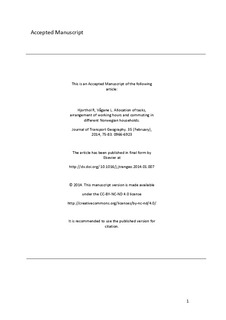| dc.contributor.author | Hjorthol, Randi | |
| dc.contributor.author | Vågane, Liva | |
| dc.coverage.spatial | Norway | nb_NO |
| dc.date.accessioned | 2019-07-05T12:27:45Z | |
| dc.date.available | 2019-07-05T12:27:45Z | |
| dc.date.created | 2014-05-14T13:35:17Z | |
| dc.date.issued | 2014-02-23 | |
| dc.identifier.citation | Journal of Transport Geography. 2014, 35 (February), 75-83. | nb_NO |
| dc.identifier.issn | 0966-6923 | |
| dc.identifier.uri | http://hdl.handle.net/11250/2603658 | |
| dc.description.abstract | Weekly working hours and commuting distance can be seen as indicators of equality/inequality between spouses. Traditionally, it is women who adjust their career more readily to meeting family obligations. In an era with a focus on equality between the genders in regard to both education and paid work, it is obvious to think of equality regarding working hours as well, and of distance to and from work. In this study we utilized data from the Norwegian Travel Survey of 2009 to examine the results of adjustments made in weekly working hours and commuting distance in families in which both husband and wife are in paid work. These indicate that the family situation is significant, and that, among other things, children in a family does not lead to any reduction in men’s working hours or commuting distance. Living in the periphery of large cities is disadvantageous for women who want to work full time, while living within a city tends to be to their advantageous in this regard. The results from the analysis of commuting distance show that women do not commute as far as men in comparable groups (working hours, family type, education, place of living, income, access to a car and occupation) and that the policy of regional enlargement is far from gender neutral. So long as it is women who adjust their labour market participation – both temporal and spatial – an enlargement of the regional/geographical labour market resulting potentially in longer commuting distances will primarily favour those who have the possibility to travel irrespectively of family situation, i.e. men, not women. | nb_NO |
| dc.language.iso | eng | nb_NO |
| dc.publisher | Elsevier | nb_NO |
| dc.rights | Attribution-NonCommercial-NoDerivatives 4.0 Internasjonal | * |
| dc.rights.uri | http://creativecommons.org/licenses/by-nc-nd/4.0/deed.no | * |
| dc.title | Allocation of tasks, arrangement of working hours and commuting in different Norwegian households | nb_NO |
| dc.type | Journal article | nb_NO |
| dc.type | Peer reviewed | nb_NO |
| dc.rights.holder | © 2014 Elsevier Ltd. All rights reserved. | nb_NO |
| dc.description.version | acceptedVersion | nb_NO |
| cristin.unitcode | 7482,0,0,0 | |
| cristin.unitname | Transportøkonomisk institutt | |
| cristin.ispublished | true | |
| cristin.fulltext | postprint | |
| cristin.qualitycode | 1 | |
| dc.identifier.doi | 10.1016/j.jtrangeo.2014.01.007 | |
| dc.identifier.cristin | 1132736 | |
| dc.source.journal | Journal of Transport Geography | nb_NO |
| dc.source.volume | 35 | nb_NO |
| dc.source.issue | February | nb_NO |
| dc.source.pagenumber | 75-83 | nb_NO |

